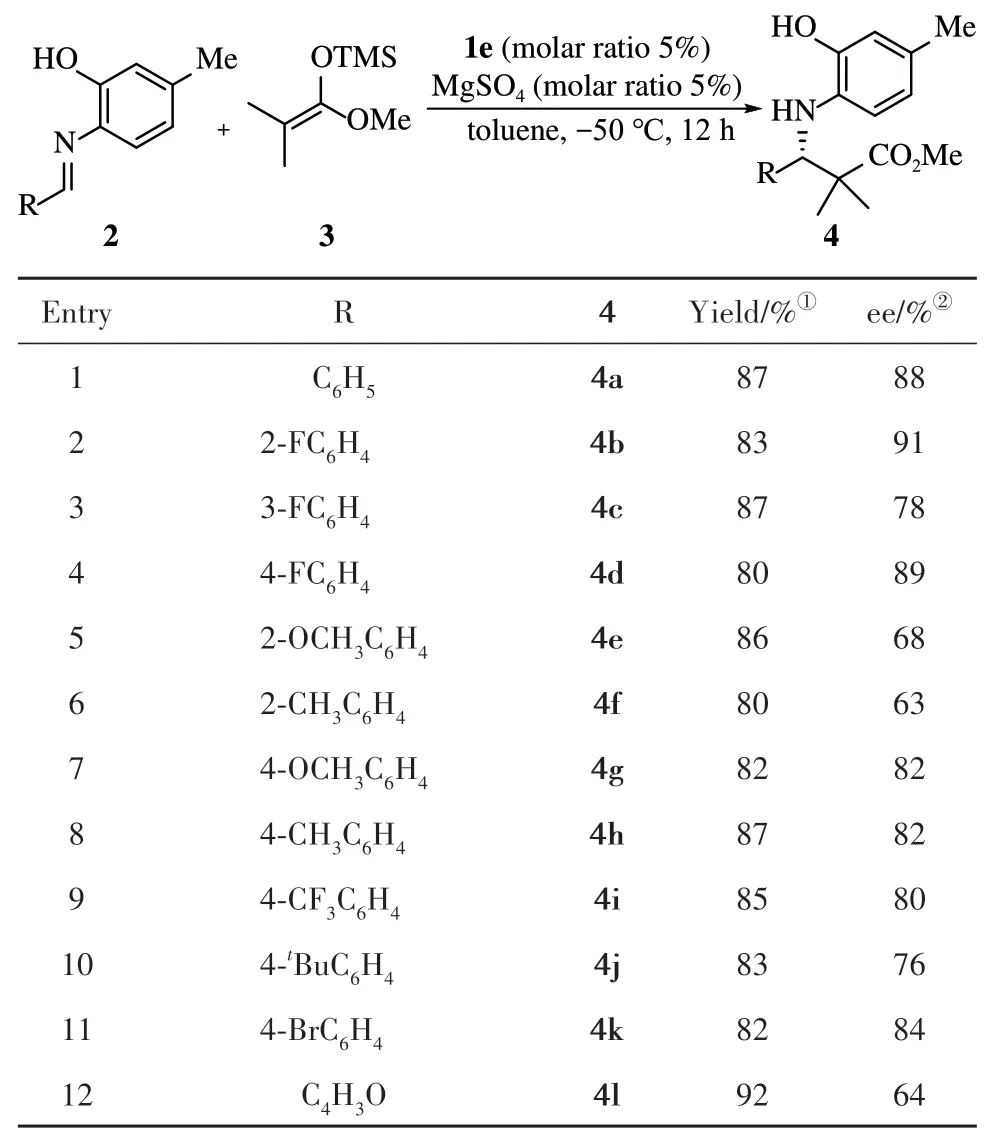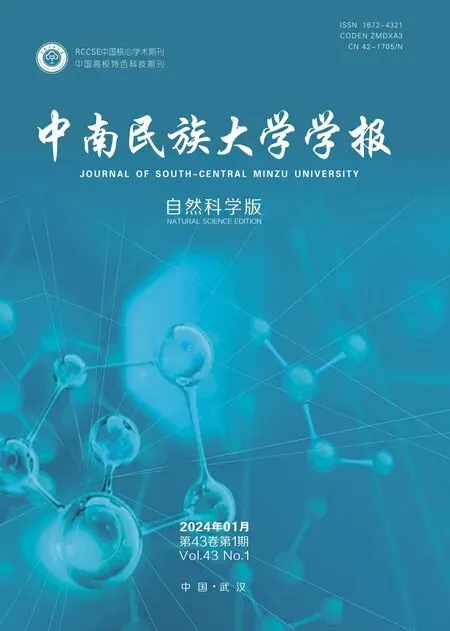Stereoselective Mannich-type reaction catalyzed by tartaric acidderived chiral phosphoric acid bearing two hydroxyl groups
LI Hongyan,WANG Cui,ZHANG Rui,HU Xiaoyun
(College of Chemistry and Materials Science,South-Central Minzu University,Wuhan 430074,China)
Abstract Several new chiral phosphoric acids bearing two hydroxyl groups derived from L-tartaric acid were synthesized as potential catalysts for the asymmetric Mannich-type reaction.The results demonstrated that this type of catalysts could effectively catalyze the reaction with moderate-to-good enantioselectivity(up to 91% ee).
Keywords chiral phosphoric acid;asymmetric Mannich-type reaction;tartaric acid
The development of novel chiral catalysts continues to be an important goal for organic chemistry.Chiral phosphoric acids are amongst the most successfully used chiral Bronsted acids for organocatalysis so far[1-5].Many types of chiral phosphoric acids with different chemical skeletons such as BINOL[6-7],H8-BINOL[8],VAPOL[9-10],SPINOL[11-12],TADDOL[13]have been synthesized and efficiently applied to various asymmetric transformations.Although numerous backbones for chiral phosphoric acids have been developed,the choice has mainly been limited to the binaphthyl derivatives.However,another type of prospective catalysts,such as TADDOL-derived phosphoric acids have not been comprehensively investigated yet.The first example of their successful application was reported in 2005 by Akiyama′s group,which investigated a Mannich-type reaction catalyzed by TADDOL-derived phosphoric acids to give high enantioselectivity(up to 92% ee)[13].This work clearly demonstrated the potential of chiral backbone derived from natural tartaric acid in enantioselective transformations.
Recently,our group reported an asymmetric Biginelli-like reaction catalyzed by a new chiral phosphoric acid bearing two hydroxyl groups derived from natural tartaric acid,that yielded a high enantioselectivity(up to 95% ee,Fig.1(a))[14].Additionally,this type of chiral phosphate could also catalyze asymmetric three-component Mannich reaction to afford a series of optically active β -amino-ketone derivatives in high yields(up to 96%)and good-tohigh enantioselectivity(up to 97% ee)via a chiral counteranion-directed strategy(Fig.1(b))[15].This new chiral phosphoric acid featured a facile preparation and low cost,and enantiopure tartaric acid as a precursor for the catalyst preparation was a conventional natural compound that made it application highly attractive from the viewpoints of sustainability and green processes.However,these catalysts have not been found a wide application so far.

Fig.1 Asymmetric reactions catalyzed by tartaric acid-derived chiral phosphoric acids bearing two hydroxyl groups图1 酒石酸衍生的双羟基手性磷酸催化的不对称反应
In order to further investigate the asymmetric catalytic performance of this new type of chiral phosphoric acids,asymmetric Mannich-type reaction of aldimines with ketene silyl acetal catalyzed by a tartaric acid-derived chiral phosphoric acid bearing two hydroxyl groups was explored(Fig(1c)).
1 Experiment
1.1 Materials and General Methods
1H and13C NMR spectra were performed on a Bruker Avance Ⅲ 400 or 600.Optical rotations were measured on a PE-341 Mc polarimeter.Melting points were determined on a VEB Wagetechnik Rapio PHMK05 instrument,and were uncorrected.Ee values were analyzed by Thermo UltiMate 3000 HPLC and SHIMADZU LC-20 AR at room temperature withnhexane/i-propanol as eluent.Diethyl L-tartrate was prepared from L-tartaric acid and ethanol.THF was freshly distilled after refluxing with Na,while SOCl2,Py,PCl3and I2were purchased and used directly.Commercially available starting materials were used without further purification if not specified.Chiral phosphoric acids 1a-1f were prepared according to previous method[15].Aldimines 2 were prepared according to literature [13].
1.2 Typical procedure for asymmetric catalyzed Mannich-type reactions
After a solution of Aldimines 2(0.15 mmol),1e(0.0075 mmol)and MgSO4(0.0075 mmol)in toluene(1.0 mL)was stirred at 25 ℃ for 0.5 h,ketene silyl acetal 3(0.225 mmol)was slowly added.The resulting mixture was stirred for 12 h and then saturated NaHCO3and KF solution,and a mixture of THF and MeOH were added and stirred at room temperature for 0.5 h.Organic phase was separated and water phase was extracted with EA.Organic phase was combined and dried,then the solvent was removed and the residue was purified via the column chromatography using petroleum ether/ethyl acetate(V(petroleum ether)∶V(ethyl acetate)=6∶1-3∶1)).
(S)-methyl-3-((2-hydroxy-4-methylphenyl)amino)-2,2-dimethyl-3-phenyl-propanoate(4a)[13]:Yield 86%,m.p.100 -105 ℃,[α]+30.6(c0.7,CH2Cl2).1H NMR(400 MHz,Chloroform-d)δ7.41-7.11(m,5H),6.43(d,J=72.9 Hz,3H),5.71(s,1H),4.54(s,2H),3.71(s,3H),2.13(s,3H),1.21(s,6H).13C NMR(151 MHz,Acetone-d6)δ205.9,176.6,144.7,140.4,134.2,128.8,128.1,127.5,126.1,120.5,114.8,112.5,64.6,51.6,47.3,24.2,20.6,20.1.Enantiomeric excess:88%,determined by HPLC(Daicel Chirapak AD-H,V(hexane)∶V(i-PrOH)=70∶30,flow rate 1.0 mL·min-1):tR=5.170 min(minor),tR=9.168 min(major).
(S)-methyl-3-(2-fluorophenyl)-3-((2-hydroxy-4-methylphenyl)amino)-2,2-dimethyl-propanoate(4b):Yield 83%,m.p.147-150 ℃,[α]+17.6(c1.5,CH2Cl2).1H NMR(600 MHz,Acetone-d6)δ8.27(s,1H),7.21(td,J=7.8,1.7 Hz,1H),7.17-7.09(m,1H),7.02-6.93(m,2H),6.40(s,1H),6.22(d,J=8.8 Hz,1H),6.19-6.16(m,1H),5.13(d,J=9.8 Hz,1H),4.90(d,J=7.6 Hz,1H),3.52(s,3H),1.91(s,3H),1.16(s,3H),1.07(s,3H).13C NMR(151 MHz,Acetone-d6)δ205.8,176.4,162.6,161.0,144.8,133.8,129.6,129.5,129.4,127.4,126.6,124.4,120.6,115.3,114.9,111.9,57.3,51.8,47.5,24.3,20.1,20.0.Anal calcd for C19H22FNO3:C 68.86,H 6.69;found:C 68.81,H 6.63.Enantiomeric excess:91%,determined by HPLC(flow rate 1.0 mL·min-1):tR=5.687 min(minor),tR=6.343 min(major).
(S)-methyl-3-(3-fluorophenyl)-3-((2-hydroxy-4-methylphenyl)amino)-2,2-dimethyl-propanoate(4c):Yield 87%,m.p.135-136 ℃,[α]+25(c1.5,CH2Cl2).1H NMR(500 MHz,Chloroform-d)δ7.18-7.14(m,1H),6.98(s,1H),6.93(dt,J=10.0,2.0 Hz,1H),6.87-6.80(m,1H),6.47(s,1H),6.34(s,1H),6.20(s,1H),5.53(s,1H),4.44(s,1H),3.63(s,3H),2.06(s,3H),1.15(s,3H),1.14(s,3H).13C NMR(151 MHz,Chloroform-d))δ176.5,161.6(J=246.1),143.9,141.1,131.4,128.4(J=7.55),127.7,123.2(J=3.02),120.2,114.2(J=57.38),113.4(J=21.14),63.8,51.3,46.3,23.4,19.5,18.9.Anal calcd for C19H22FNO3:C 68.86,H 6.69;found:C 68.82,H 6.65.Enantiomeric excess:78%,determined by HPLC(flow rate 1.0 mL·min-1):tR=5.360 min(minor),tR=6.058 min(major).
(S)-methyl-3-(4-fluorophenyl)-3-((2-hydroxy-4-methylphenyl)amino)-2,2-dimethyl-propanoate(4d)[13]:Yield 80%,m.p.120-122 ℃,[α]+5.9(c1.4,CH2Cl2).1H NMR(400 MHz,Acetone-d6)δ8.41(s,1H),7.38(dd,J=8.6,5.5 Hz,2H),7.05(t,J=8.8 Hz,2H),6.54(s,1H),6.38-6.18(m,2H),5.19(d,J=8.8 Hz,1H),4.64(d,J=6.6 Hz,1H),3.63(s,3H),2.04(s,3H),1.25(s,3H),1.17(s,3H).13C NMR(101 MHz,Acetone-d6)δ176.2,163.2,160.8,144.4,136.1,133.7,130.1,125.9,120.2,114.5,112.2,63.7,51.3,47.0,23.7,20.3,19.7.Enantiomeric excess:89%,determined by HPLC(flow rate 1.0 mL·min-1):tR=4.623 min(minor),tR=8.065 min(major).
(S)-methyl-3-((2-hydroxy-4-methylphenyl)amino)-3-(2-methoxyphenyl)-2,2-dimethylpropanoate(4e):Yield:86%,m.p.150-52 ℃,[α]+4.3(c1.4,CH2Cl2).1H NMR(400 MHz,Acetone-d6)δ8.35(s,1H),7.24-7.13(m,2H),6.97(d,J=8.2 Hz,1H),6.88-6.79(m,1H),6.51(s,1H),6.30(d,J=2.5 Hz,2H),5.30(d,J=9.8 Hz,1H),5.21(d,J=6.6 Hz,1H),3.90(s,3H),3.63(s,3H),2.03(s,3H),1.24(s,3H),1.16(s,3H).13C NMR(101 MHz,Acetone-d6)δ176.6,158.2,144.4,134.1,128.3,128.2,125.5,120.2,120.1,114.5,111.7,111.6,110.5,56.4,54.9,51.2,47.4,24.1,19.7.Anal calcd for C20H25NO4:C 69.95,H 7.34;found:C 69.82,H 7.28.Enantiomeric excess:69%,determined by HPLC(flow rate 1.5 mL·min-1):tR=3.908 min(minor),tR=6.678 min(major).
(S)-methyl-3-((2-hydroxy-4-methylphenyl)amino)-2,2-dimethyl-3-(o-tolyl)-propan-oate(4f):Yield 80%,m.p.135-136 ℃,[α]+13.6(c0.9,CH2Cl2).1H NMR(600 MHz,Acetone-d6)δ8.23(s,1H),7.15(d,J=9.2 Hz,1H),7.00(d,J=9.0 Hz,1H),6.96(d,J=3.5 Hz,2H),6.38(s,1H),6.19(d,J=7.9 Hz,1H),6.12(s,1H),5.14(d,J=7.5 Hz,1H),4.82(s,1H),3.51(s,3H),2.39(s,3H),1.89(s,3H),1.13(s,3H),1.08(s,3H).13C NMR(151 MHz,Acetone-d6)δ176.9,144.9,138.9,137.1,134.3,130.6,127.5,127.2,125.9,120.5,114.9,112.2,112.1,59.4,51.7,48.4,24.4,20.1.Anal calcd for C20H25NO3:C 73.37,H 7.70;found:C 73.32,H 7.67.Enantiomeric excess:63%,determined by HPLC(flow rate 1.0 mL·min-1):tR=4.892 min(minor),tR=9.292 min(major).
(S)-methyl-3-((2-hydroxy-4-methylphenyl)amino)-3-(4-methoxyphenyl)-2,2-dimethylpropanoate(4g)[13]:Yield 82%,m.p.124-125 ℃,[α]+18.5(c1.2,CH2Cl2).1H NMR(400 MHz,Acetone-d6)δ8.38(s,1H),7.24(d,J=8.7 Hz,2H),6.82(d,J=8.7 Hz,2H),6.53(s,1H),6.28(d,J=5.5 Hz,2H),5.13(d,J=10.0 Hz,1H),4.57(d,J=6.5 Hz,1H),3.73(s,3H),3.62(s,3H),2.03(s,3H),1.22(s,3H),1.16(s,3H).13C NMR(151 MHz,Acetone-d6)δ176.4,158.9,144.4,133.9,131.7,129.4,125.7,120.1,114.5,113.0,112.2,63.7,54.5,51.2,47.0,23.8,20.2,19.8.Enantiomeric excess:82%,determined by HPLC(flow rate 1.5 mL·min-1):tR=3.580 min(minor),tR=9.351min(major).
(S)-methyl-3-((2-hydroxy-4-methylphenyl)amino)-2,2-dimethyl-3-(p-tolyl)-propanoate(4h)[13]:Yield 87%,m.p.116 -117 ℃,[α]+20.5(c1.2,CH2Cl2).1H NMR(400 MHz,Acetone-d6)δ8.39(s,1H),7.24(d,J=7.9 Hz,2H),7.17-6.96(m,2H),6.56(s,1H),6.42-6.19(m,2H),5.19(d,J=8.9 Hz,1H),4.80-4.42(m,1H),3.65(s,3H),2.27(s,3H),2.06(s,3H),1.26(s,3H),1.19(s,3H).13C NMR(151 MHz,Acetone-d6)δ176.4,144.5,136.9,136.5,133.9,128.4,125.7,120.2,114.5,114.4,112.2,64.1,51.3,47.0,23.8,20.2,19.8.Enantiomeric excess:82%,determined by HPLC(flow rate 1.0 mL·min-1):tR=4.635 min(minor),tR=9.847 min(major).
(S)-methyl-3-((2-hydroxy-4-methylphenyl)amino)-2,2-dimethyl-3-(4-(trifluoromethyl)phenyl)propanoate(4i):Yield 85%,m.p.182-185 ℃,[α]+9.4(c1.2,CH2Cl2).1H NMR(600 MHz,Acetone-d6)δ8.36(s,1H),7.50(d,J=8.3 Hz,2H),7.46(d,J=8.2 Hz,2H),6.42(s,1H),6.17(d,J=8.0 Hz,1H),6.12(dd,J=8.0,4.0 Hz,1H),5.15(d,J=8.7 Hz,1H),4.61(d,J=7.7 Hz,1H),3.52(s,3H),1.90(s,3H),1.16(s,3H),1.06(s,3H).13C NMR(151 MHz,Acetone-d6)δ176.3,145.5,144.8,133.8,129.5,129.2,127.5,126.5,125.7,125.0,123.9,120.5,115.0,112.3,64.4,51.8,47.2,24.1,20.8,20.1.Anal calcd for C20H22F3NO3:C 62.98,H 5.81;found:C 62.92,H 5.78.Enantiomeric excess:80%,determined by HPLC(flow rate 1.0 mL·min-1):tR=3.991 min(minor),tR=6.871 min(major).
(S)-methyl-3-(4-(tert-butyl)phenyl)-3-((2-hydroxy-4-methylphenyl)amino)-2,2-dimethylpropanoate(4j):Yield 83%,m.p.175-176 ℃,[α]+133.3(c0.3,CH2Cl2).1H NMR(400 MHz,Acetone-d6)δ8.40(s,1H),7.56-7.15(m,4H),6.53(s,1H),6.32(s,2H),5.17(d,J=9.2 Hz,1H),4.63(d,J=6.6 Hz,1H),3.63(s,3H),2.04(s,3H),1.26(s,9H),1.22(s,3H),1.16(s,3H).13C NMR(101 MHz,Acetone-d6)δ176.4,149.7,144.2,136.9,128.1,125.7,124.5,120.2,114.4,112.0,63.8,51.2,47.0,34.1,30.8,20.1,19.7.Anal calcd for C23H31NO3:C 74.76,H 8.46;found:C 74.62,H 8.39.Enantiomeric excess:76%,determined by HPLC(flow rate 1.0 mL · min-1):tR=3.810 min(minor),tR=4.432 min(major).
(S)-methyl-3-(4-bromophenyl)-3-((2-hydroxy-4-methylphenyl)amino)-2,2-dimethylpropanoate(4k):Yield 82%,m.p.135-136 ℃,[α]+11.5(c0.8,CH2Cl2).1H NMR(600 MHz,Chloroform-d)δ7.41(d,J=8.2 Hz,2H),7.16(d,J=8.3 Hz,2H),6.66~6.11(m,3H),5.57(s,1H),4.53(d,J=62.2 Hz,2H),3.71(s,3H),2.14(s,3H),1.20(d,J=8.0 Hz,6H).13C NMR(151 MHz,Acetoned6)δ176.1,144.4,139.7,133.5,130.8,130.5,126.1,121.8,120.2,114.6,112.1,63.8,51.4,46.8,23.7,20.4,19.8.Anal calcd for C19H22BrNO3:C 58.17,H 5.65;found:C 58.03,H 5.59.Enantiomeric excess:84%,determined by HPLC(flow rate 1.0 mL·min-1):tR=4.620 min(minor),tR=10.194 min(major).
(S)-methyl-3-(furan-2-yl)-3-((2-hydroxy-4-methylphenyl)amino)-2,2-dimethyl-propanoate(4l):Yield 92%,m.p.135-136 ℃,[α]+63.6(c7.5,CH2Cl2).1H NMR(600 MHz,CDCl3)δ7.31(s,1H),7.19(s,1H),6.57(s,1H),6.37(d,J=7.3 Hz,1H),6.32(d,J=7.7 Hz,1H),6.19(s,1H),6.02(d,J=3.1 Hz,1H),4.36(s,1H),3.69(s,3H),2.11(s,3H),1.26(s,3H),1.10(s,3H).13C NMR(151 MHz,CDCl3)δ177.19,151.62,147.72,140.80,131.84,129.93,119.60,119.47,114.81,109.07,108.19,59.95,51.40,46.36,23.40,19.82,18.37.Anal calcd for C17H21NO4:C 58.17,H 5.65;found:C 58.13,H 5.62.Enantiomeric excess:64%,determined by HPLC(flow rate 1.0 mL·min-1):tR=5.193 min(minor),tR=6.162 min(major).
2 Results and discussion
The reaction of an aldimine 2a with ketene silyl acetal 3 was used as a model reaction.The examination results by using of 5 %(molar ratio)of 1 are shown in Tab.1.When 1a(Ar=Ph),1b(Ar=4-MeC6H4)and 1c(Ar=4-tBuC6H4)were employed in toluene at -78°C for 24 h,no reaction took place and initial 2a was fully recovered(Entries 1-3).However,introduction of the electron-withdrawing substituents into the aromatic ring of 1 had a positive effect.Hence,when 1d(Ar=4-FC6H4)was used,β-amino ester 4a was obtained in 35% yield and 35% ee(Entry 4).Further increasing the electron-withdrawing ability in the case1e(Ar=4-CF3C6H4)resulted in enhancing both the chemical yield(72%)and enantioselectivity(61%)(entry 5).While 1f(Ar=3,5-(CF3)2C6H3)was used,chemical yield(75% yield)slightly increased and enantioselectivity(7%)dramatically dropped(Entry 6).This observation fully coincided with the effectiveness of electron-withdrawing substituents in the catalytic asymmetric Mannich-type reaction with TADDOL-derived chiral phosphoric acids reported by the Akiyama′s group[13].

Tab.1 Optimization of the reaction conditions表1 反应条件的优化
Based on these results,1e was chosen as the most effective catalyst and the role of reaction temperature was examined.Appropriate rising the temperature improved both the chemical yield(82%)and enantioselectivity(84%,Entry 7).However,increasing the temperature,further increased the yield,but the enantioselectivity decreased(Entry 8),further increasing the temperature led to no reaction(Entry 9),which may be related with readily decomposability of aldimine.Influence of the solvent was also investigated at -50 ℃(Entries 7,10-18),and the results indicated that toluene showed the best performance(Entry 7),while more polar solvents such as CH2Cl2,THF,methanol and nitrobenzene dramatically decreased the enantioselectivity(Entries 10-16),and MeOH gave a racemic product(Entry 13).Furthermore,the addition of 4Å MS and MgSO4were explored as corresponding additive.The results indicated that addition of 5 %(molar ratio)MgSO4increased both the chemical yield(87%)and enantioselectivity(88%,Entry 20).
With the optimized conditions in hand,scope of this catalytic strategy has been broadened by using various aldimine 2 components.All aldimines 2 were synthesized by the reaction of aromatic aldehydes with 2-amino-5-methylphenol according to the standard procedure.As shown in Tab.2,the majority of reactions proceeded smoothly(with 80%-92% yield)in the presence of established combination(5%(molar ratio)of 1e and MgSO4)to yield corresponding β-amino esters in the medium-to-good enantioselectivities.However,the results indicated that the steric hindrance of R substituent at theo-position and atomic volume of aldimine 2 played a decisive role in the enantioselective control of this reaction(Entries 2,5,6),and F at theo-position gave the best result(Entry 2).However,as expected the corresponding steric hindrance of substituent R at thep-positioin of 2 had a smaller influence(Entries 7 -11).In general,substitution at thepposition led to higher enantioselectivities compared to that at theo-position(Entries 5,6vs7,8).Furthermore,furaldehyde as a reaction substrate was also examined,it gave excellent yield(92%)and moderate enantioselectivity(64% ee).The stereochemistry of β-amino esters 4 was determined by comparison of the optical rotation and HPLC retention time with the literature data.

Tab.2 Substrate scope of asymmetric Mannich-type reactions表2 不对称Mannich-type反应的底物范围
Compared to the previously reported asymmetric Mannich-type reaction of aldimine component and ketene silyl acetal catalyzed by TADDOL-derived chiral phosphoric acids[13],the synthesized tartaric acid-derived chiral phosphoric acid 1e showed similar asymmetric catalytic ability.Additionally,a broader substrate scope was explored.
3 Conclusion
In summary,a new catalytic system for the asymmetric Mannich-type reaction between various aldimine components 2 and ketene silyl acetal 3 catalyzed by tartaric acid-derived chiral phosphoric acid 1 has been developed.It was established that an equimolar(molar ratio 5%)amount of phosphoric acid 1e and MgSO4efficiently promoted the reaction affording optically active β-amino esters in high yields and with moderate-to-good enantioselectivity.

